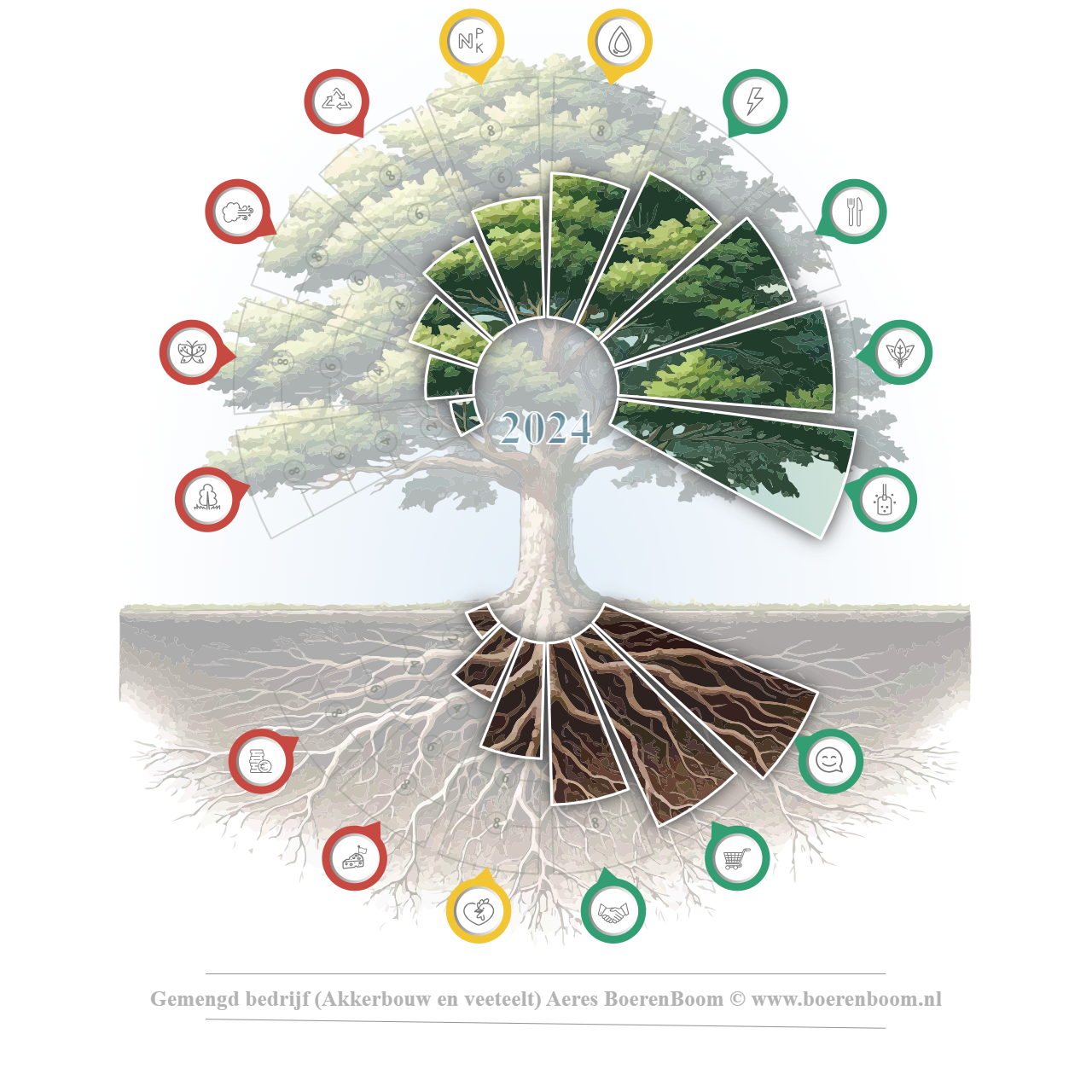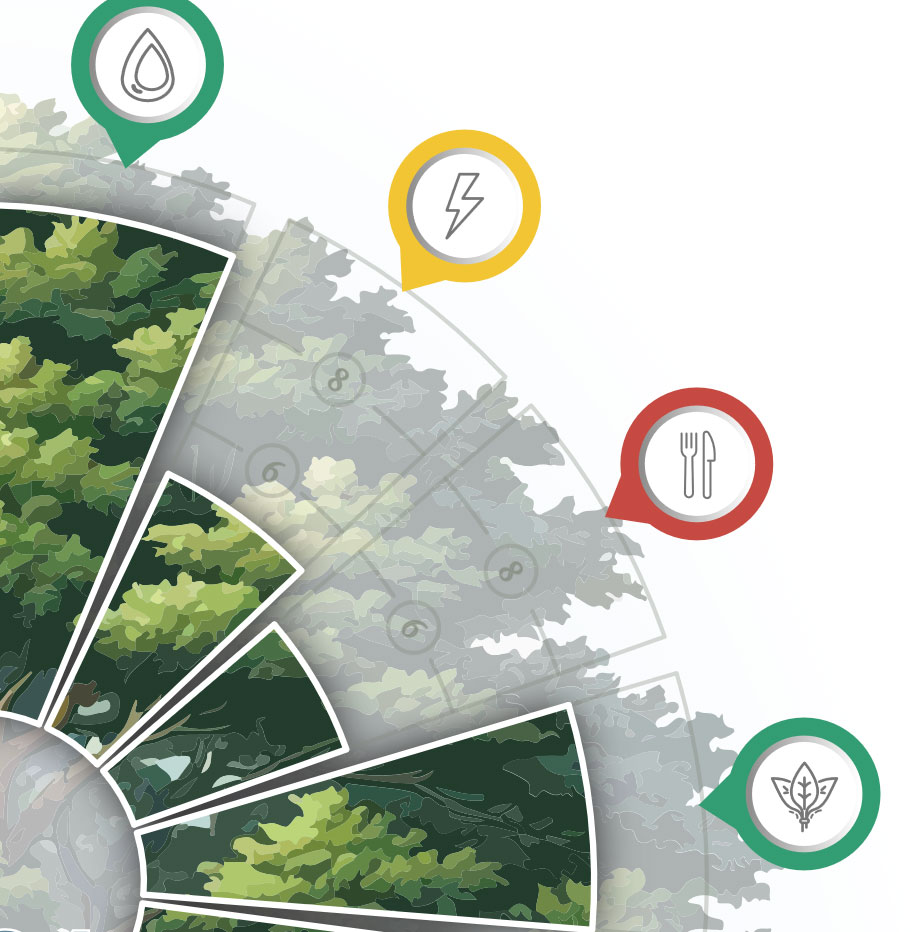The tree as a representation of a farm. Like a tree, a farm has a location and is part of its environment; a farm is socially rooted and ecologically connected on its location. The FarmingTree provides insight these relations for a specific farm. We are happy to explain how it works and in which situations it is a valuable tool in practice.

'How can I make clear what I do as a farmer for my environment?'
The FarmingTree uses 16 themes that in total comprise the entire farm: 6 social and 10 ecological themes. This allows a farmer to portray the story of the farm in its entirety. In the FarmingTree the central point of view is the farm rather than the products produced on the farm. From a products perspective a specific sustainability label gives the consumer information on and assurance of the production process. However, as it puts the focus on a specific aspects, many other aspects are out of sight. Aspects which do affect the social and ecological embedding of the farm on its location. The FarmingTree allows the farmer to tell the complete story, supporting both communication purposes as well as the farmers’ awareness on this range of aspects. Which aspects are already doing well and for which aspects there is room for improvement? The FarmingTree aims to be easily applicable to all farms.
The FarmingTree supports to be more focused on the (potential) positive effects of a farm for the living environment.
An inspection for a specific sustainability label checks whether the relevant aspects of the production process fits into that specific system. The FarmingTree is about the farm in its entirety and places the emphasis on the farm rather than on the product. Two points given as feedback were: ‘It is refreshing for the farmer to be able to tell the whole story’ and 'it brings important subjects to the table that would otherwise easy be overlooked'.
The FarmingTree is not a replacement for sustainability labels, they are and remain important. The FarmingTree provides a tool to assess the relationship of the farm with the social and ecological environment. It allows as well an assessment on which aspects of these relationships can or should be developed further and what is needed to do so; the assessment schemes for the different themes allows for a more clear and focused discussion on the development of the farm.
The FarmingTree works well as a reflection tool when working on farm strategy. The insights provide a good basis to assess the individual themes and it provides an oversight on the farm as a whole. This oversight and insight creates a good overview for the further development of the farm strategy.

Each theme has a key phrase that indicates what the theme is about and thus as well what it is not about. The objective describes the development leading to the highest score and the activities and adaptations reflect how the company can take steps in this direction.
Each theme has an assessment scheme with scores from 1-10, the levels are based on the actual activities and adaptations on the farm. Scores at the levels 1-4 indicate a need to further develop for this thema, scores 5-7 mark the transition to the high level scores 8-10. There is not the necessity for a farm to reach high scores for each theme as not all themes are relevant in light of the strategy of the farm. The total of the scores for all themes is represented in the FarmingTree. A representation of a farm for the situation in the past, the present and the planned situation in the future, provides an overview on the development of the farm over time.
The descriptions are as concrete as possible while remaining applicable to multiple types of farms. The assessment schemes are either based on a 'ladder system' or a 'stack system'. A ladder system means that in a given score, all lower scores are included by nature. With a stacking system, the measures can be taken independently, in this cases it is the total number of measures taken that defines the score for that theme.
A theme can also be not relevant or not yet assessed, leading to a missing score for the theme.
Important: a farm will not be able to score high for all themes and this is good as it is. Not all themes are relevant for a specific farm. However, a minimum level for each theme is deemed appropriate as a very low score for a theme indicate that there is action needed.
The FarmingTree model builds upon on-farm activities and adaptions. This bring the question why not use Key Performance Indicators (KPI’s). There are two main reasons for this choice: 1) The FarmingTree models aims to be applicable for all kinds of faming, and 2) a KPI is a calculation based on specific datasets, these datasets are not available for every farm. We do however see KPI’s as a means to substantiate the highest level for relevant themes.

The FarmingTree was developed by the professorship Environment inclusive farm entrepreneurship at Aeres University of Applied Sciences, Dronten, the Netherlands. The development was supported by Regieorgaan SIA (part of NWO), Ministry of Agriculture, ASR Real Estate, Province of Overijssel, students and entrepreneurs.
An important source of inspiration is the 'Doughut Economy' model of British economist Kate Raworth. She introduced a model with a social floor and ecological ceiling, this floor and ceiling demarcate the save and just space for economic activity. In the FarmingTree model this translates to scores of the levels 1 to 4 as it indicates that a social or ecological price is paid.